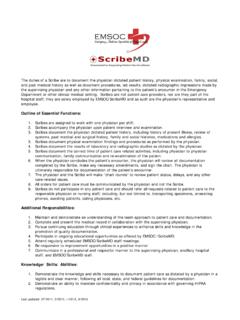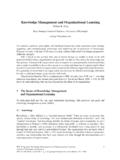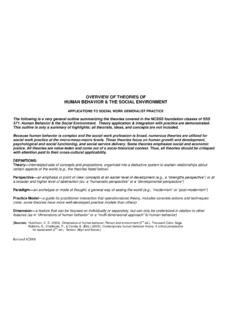Transcription of Perspectives on Organizational Change: Systems …
1 The Innovation Journal: The Public Sector Innovation Journal, Volume 13(3), 2008, article 3. 1 Perspectives on Organizational change : Systems and Complexity Theories Francis Amagoh Department of Public Administration Kazakhstan Institute of Management, Economics and Strategic Research (KIMEP) Almaty OR Abstract It is becoming increasingly important for organizations to gain competitive advantage by being able to manage and survive change . This paper presents two theoretical paradigms ( Systems and complexity theories) through which Organizational change processes can be fruitfully examined.
2 Systems and complexity theories are two valuable Perspectives that can equip Organizational leaders with the requisite knowledge and understanding of how to respond and adapt to the uncertainties and demands of global change . These two paradigms are particularly useful in the areas of Organizational intelligence, Organizational design, knowledge management, and corporate strategy, to mention but a few. Key Words: Systems Theory, Complexity Theory, Organizational change , And Organizational Transformation Introduction The ability of organizations to manage and survive change is becoming increasingly important in an environment where competition and globalization of markets are ever intensifying (Cao and McHugh, 2005: 475).
3 Through the mid-20th century, there had been increased attempts to apply theories of Organizational change to the analysis of human organizations (Byeon, 2005: 223). The first attempt, which applied concepts of Systems theory was mainly concerned with equilibrium and stability, and their maintenance through control of negative feedback (Montuori, 2000: 66; Byeon, 2005: 223; Foster, 2005: 877). The Systems concept views organizations as constantly interacting with their environment. The Organizational environment is comprised of a set of relationships between agents or stakeholders and other factors that may be beyond the control of the organization (Mason, 2007: 10).
4 With the ever-increasing complexity of the Organizational environment, the Systems concepts no longer seems adequate in dealing with complex phenomena. This shortcoming, among others, has led to the emergence of complexity theory which focuses on the use of such terms as entropy, non-equilibrium, instability, and the emergence of new patterns and structures. In the complexity paradigm, Systems are usually considered to be evolving or self-organizing into something new (Ferlie, 2007: 155; Byeon, 2005: 226; White, 2000: 167). The Innovation Journal: The Public Sector Innovation Journal, Volume 13(3), 2008, article 3.
5 2 Since the most prevalent trends in contemporary organizations are towards continuous and pervasive change and increasing interdependencies (White, 2000: 162), close parallels can be drawn between the private and public sectors where there are broadly similar environmental challenges. Within this context, public and private organizations are approaching a turbulent environment characterized by increasing uncertainties. These uncertainties are due to dramatic changes that have taken place in the political and economic environment, as well as changes in technology. To help understand change better and manage the process more effectively, a more dynamic and comprehensive view of change management has been suggested as a way forward (Cao and McHugh, 2005: 480).
6 By integrating complexity and Systems theories, the disruptive, and fluid processes of Organizational change may be better understood (Styhre, 2002: 343). This paper presents Organizational change through the Perspectives of Systems and complexity theories, and underscores that an appreciation of these two paradigms can aid Organizational leaders in responding more effectively to the environmental uncertainties of contemporary organizations. It begins with a review of Systems and complexity theories, followed by implications of both theories for organizations. Systems Theory Systems theory is a concept that originated from biology, economics, and engineering, which explores principles and laws that can be generalized across various Systems (Yoon and Kuchinke, 2005: 15; Alter, 2007: 35; Dubrovsky, 2004: 112).
7 A system is a set of two or more elements where: the behavior of each element has an effect on the behavior of the whole; the behavior of the elements and their effects on the whole are interdependent; and while subgroups of the elements all have an effect on the behavior of the whole, none has an independent effect on it (Skyttner, 1996: 7). In other words, a system comprises of subsystems whose inter-relationships and interdependence move toward equilibrium within the larger system (Martinelli, 2001: 73; Steele, 2003: 2). The concept of general Systems theory (GST) was first advanced by Ludwig von Bertanlanffy in 1940 but did not gain prominence until the 1960 s.
8 GST is primarily concerned with how Systems operate, and integrates a broad range of Systems by naming and identifying patterns and processes common to all of them (Bausch, 2002: 421; Capps and Hazen, 2002: 309). By use of such an overarching terminology, GST tries to explain the origin, stability, and evolution of all Systems (Alter, 2007: 36; Montuori, 2000: 65). An important aspect of GST is the distinction between open and closed Systems . All conventional models and theories of organizations typically embraced the closed Systems approach to the study of organizations by assuming that the main features of an organization are its internal elements.
9 While closed Systems approach consider the external environment and the organization s interaction with it, to be for the most part inconsequential, open Systems approach views the organizations interaction with the external environment as vital for Organizational survival and success. In open Systems , any change in any elements of the system causes changes in other elements (Shafritz and Russell, 2005: 241; Wang, 2004: 396). The lack of coordination between the organization and its external environment in closed Systems inhibit the organization s capacity to import sufficient energy from its environment for sustenance.
10 Three major pioneers in GST are Kenneth Boulding, Daniel Katz, and Robert Kahn. According to Boulding (1956: 203), GST studies all thinkable relationships abstracted from any concrete situation or body of empirical knowledge. In his hierarchical framework of Systems , Kenneth Boulding arranged Systems in a hierarchy of complexity (Martinelli, 2001: 74; Bausch, 2002: 418, Stewart and Ayres, 2001: 83). The hierarchical approach classifies The Innovation Journal: The Public Sector Innovation Journal, Volume 13(3), 2008, article 3.









